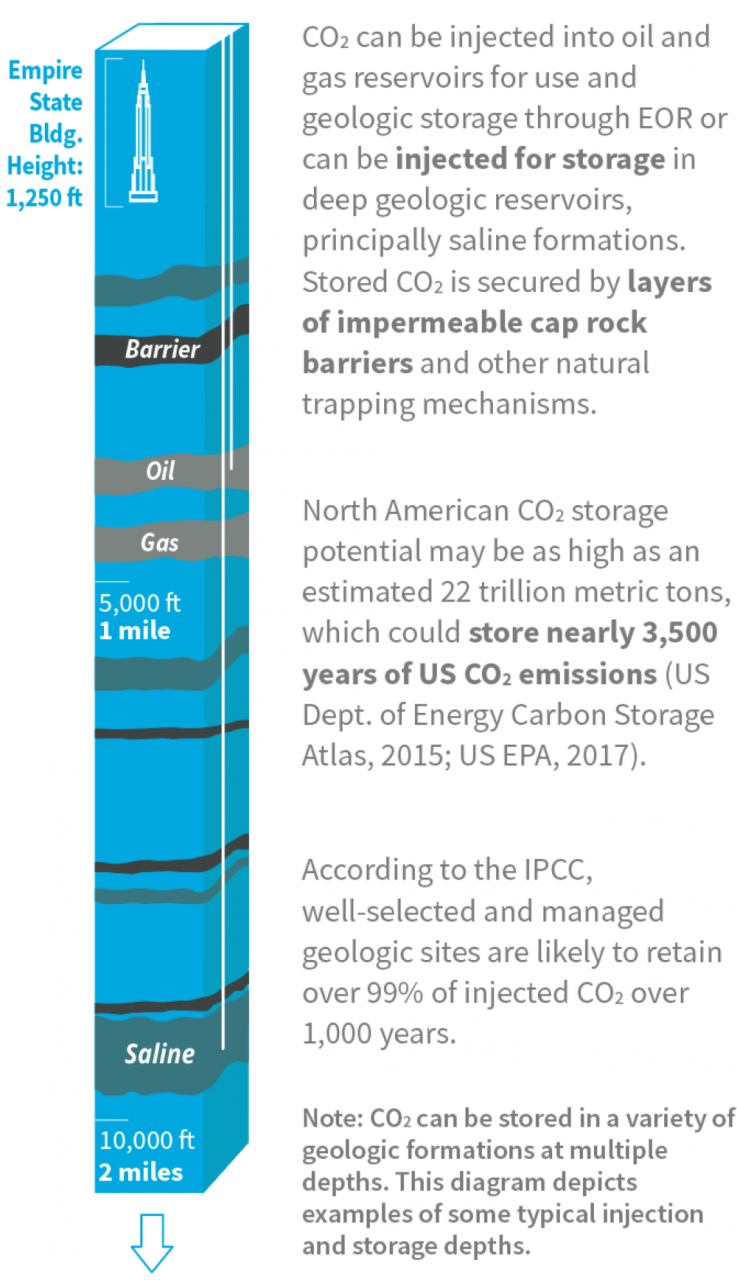Carbon Capture 101
Carbon capture is an essential part of GPI’s work to achieve a zero-carbon energy system by midcentury. GPI engages a broad set of interests at the state and federal levels to increase the deployment of carbon capture projects and infrastructure. We developed a carbon capture 101 fact sheet (PDF and text below) as a starting point for learning about what carbon capture is and why it’s an important economic and environmental strategy.
Download Carbon Capture 101 Fact Sheet
What is carbon capture?
Carbon capture refers to a group of technologies that prevent industrial and electric power facility carbon emissions from reaching the atmosphere or remove carbon dioxide (CO2) from the atmosphere.
Carbon capture projects generally include the following steps depending on the project type (e.g., many projects include beneficial use as part of the carbon storage process):
  |
  |
| Capture technology removes emissions from a range of facilities (e.g., power plants, refineries, ethanol and fertilizer plants, and steel mills) or directly from the atmosphere. Capture equipment can be retrofitted to existing facilities or built into new facilities. | Captured CO2 is transported via pipeline from the emissions source to geologic formations. There are currently about 5,100 miles of CO2 pipelines in the United States. Trucks occasionally transport CO2 for short distances. |
  |
  |
| Beneficial use of captured carbon occurs when CO2 or carbon monoxide (CO) becomes a feedstock to produce lower carbon intensity fuels, chemicals, materials and products (e.g., concrete). The largest commercial use is the injection of CO2 for enhanced oil recovery (CO2-EOR). | Geologic storage of captured CO2 occurs in oil and gas fields through the process of CO2-EOR, or through injection into other deep geologic reservoirs, principally saline formations. |
Why is carbon capture important?
Authoritative analysis by the International Energy Agency and Intergovernmental Panel on Climate Change (IPCC) shows the critical role carbon capture must play in achieving US and global carbon reduction targets by 2050. Carbon capture enables many industries to reduce or eliminate their carbon emissions while protecting and creating high-wage jobs.
Moreover, for key carbon-intensive industries such as steel and cement, significant CO2 and CO emissions result from the chemistry of the production process itself, regardless of energy inputs.
Thus, carbon capture is an essential emissions reduction tool for major industrial sectors that are otherwise difficult to decarbonize.
Figure 1 illustrates that emissions from the US industrial sector are as significant as the electric or transportation sectors.
Figure 1. Percentage of total US CO2 emissions by sector

Carbon capture is proven
The US has nearly a half-century’s commercial experience safely capturing, transporting, using, and storing CO2 at large-scale, with no loss of life or significant environmental incident since projects began in the 1970s. Globally, there are 19 large-scale projects in operation (10 of which are in the US), 4 under construction and 28 projects in various stages of development. Geologic storage projects operate under existing state and federal regulations. CO2, which is nonflammable and nontoxic, can be stored securely in suitable geologic formations by physical and chemical trapping mechanisms. Storage sites are monitored to ensure that the CO2stays underground and out of the atmosphere and that water resources are protected.
Figure 2. CO2 injection and storage

Carbon capture benefits the economy & environment
- Enables production of low- and zero-carbon fuels, electricity, chemicals, materials, and products that transform captured carbon into economic value, sustaining and creating industries and high-paying jobs.
- Increases the competitiveness of industries by helping them meet growing societal and market expectations for emissions reductions and cleaner, lower-carbon products.
- Lowers the cost of reaching a zero-carbon energy system. The IPCC estimates a nearly 140 percent increase in the cost of meeting midcentury emissions reduction goals if carbon capture is not deployed economywide.
Cost of capture
While carbon capture is cost-effective today on a per-ton basis as part of a portfolio of other low- and zero-emissions reductions, more project deployment will lower costs further. Costs currently range from an estimated $10–$20 per ton in industrial sectors with highly concentrated CO2 emissions, $40–$60 per ton for industrial facilities with mid-tier CO2 concentrations, and $55–$75 per ton for fossil fuel-based electric power plants.
Table 1. Factors that influence the cost of capture
Factor |
Description |
| CO2> purity | Highly concentrated CO2 sources (e.g., ethanol) require less energy to capture and are thus less costly to process before transport. |
| Facility operation | Facilities that maximize utilization rates of carbon capture equipment reduce effective capital costs relative to tons of CO2 captured. |
| Policy Environment | Policies like the recently reformed federal 45Q tax credit, tax incentives, low-cost financing, and state low carbon fuels policies help reduce costs of capture and increase investment in carbon capture projects. Additional federal and state incentives and other policies are under consideration. |
| Regional carbon pipeline infrastructure | Transporting CO2 long distances increases the cost of carbon capture. Scale-efficient, high-volume CO2 trunk lines create economies of scale and can lower the cost per ton of CO2 transport. Regional project coordination may enable higher volume pipeline construction and lower project costs, as would low-cost federal financing of CO2 transport infrastructure. |
| Market for CO2 | When current and emerging markets increase demand for CO2, it increases the market feasibility for carbon capture projects. |
| Equipment & installation | There is relatively minimal variation by industry in the cost of capture equipment itself. However, facility-specific assessments and installation, as well as variation in financing rates set by investors and lenders, lead to differing project costs within industry sectors. |
Learn about the GPI’s work at the state level to support carbon capture projects and infrastructure by exploring our Carbon Capture Ready resources. Learn about federal carbon capture policy priorities by checking out the Federal Policy Blueprint, a consensus document of the over 70 members from industry, labor, and NGOs that make up the Carbon Capture Coalition, which is convened by GPI.

